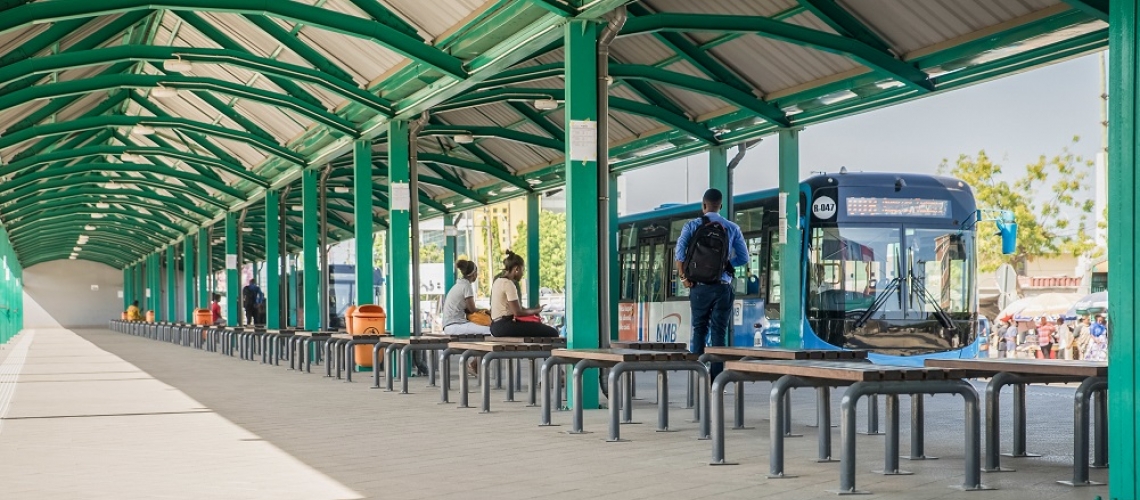Greening public investments in Africa - Where can finance ministries start?

Photo of a platform on Dar es Salaam, Tanzania's new bus transit system
Africa needs to bridge a serious infrastructure gap. How can we paint the bridge green?
Between 2013 and 2017, the average annual funding for infrastructure development in Africa was $77 billion—double the annual average in the first six years of this century. The impact of the COVID-19 pandemic on economic growth threatens this trajectory. Understanding the inefficiencies in government financing in the infrastructure sector and adopting principles to reallocate spending toward more efficient and sustainable outcomes will be important for recovery and stimulus packages.
Many countries in Africa are undertaking reforms in the management of public investments to support competitiveness and service delivery outcomes. Kenya is reviewing its public investment portfolio to eliminate underperforming projects. It has prioritized investment in municipal infrastructure as part of a drive to provide 500,000 new affordable housing units in five years. Ethiopia is undertaking a similar exercise to attract global apparel manufacturers via the creation of industrial development zones.
While the immediate focus on competitiveness and service delivery is essential, these policy reforms also are an opportunity for public investment to play a key role in the transition to a green economy. Sustainable and resilient infrastructure is the backbone of economic development and a cornerstone of the U.N. Sustainable Development Goals. Finance and planning agencies in the region can use these reforms as an opportunity to (i) develop coherent policy and legal frameworks governing climate-smart infrastructure investments, (ii) craft medium-term public investment plans addressing green transition goals, and (iii) develop strategies for financing these plans.
A coherent regulatory framework for green infrastructure governance.
The recent push to improve the management of public investments, state-owned enterprises, and public-private partnerships has resulted in a proliferation of legal frameworks and administrative arrangements that are not always consistent and synergistic regarding environmental standards and climate change considerations. Governments in the region can benefit from an integrated governance framework for infrastructure investments that mainstreams nationally applicable emissions and resilience standards.
Climate-smart medium-term public investment plans.
Many governments in the region see capital budgeting as an annual exercise driven by budget limitations and political expediency. Where medium-term perspectives in planning exist, they are often aspirational and speculative. Efforts to modernize public investment management systems can be complemented with infrastructure service gap analyses incorporating green growth and climate resilience objectives in a whole-of-government and data-driven way. This can inform the development of a climate-smart medium-term public investment plan anchored in a strategy for a long-term transition to a capital stock that is green and climate resilient.
Resource mobilization strategies to close the green infrastructure gap.
As fiscal pressures mount, governments in Africa will need to deepen their access to innovative sources of financing including those earmarked for climate finance and social impact. Finance and planning agencies also will need to shift their thinking on green growth and climate resilience from one-off projects driven from the outside to viewing resilience as a recurring expense. A structured process in this vein can inform the development of a resource mobilization strategy that underpins the climate-smart medium-term public investment plans. Considering the prominence of decentralization programs in many countries, and the challenges subnational governments face in accessing green finance, finance and planning agencies will need to consider instruments such as budget reallocations, green bonds, national climate funds, insurance and guarantee financing for local projects, and subnational development banks to support local and regional green infrastructure outcomes.
Nearly 600 million people in Sub-Saharan Africa lack access to grid electricity—accounting for over two-thirds of the global population without power. Many small economies in Africa rely on small-scale, oil-based power generation that costs far more than hydropower. Innovative initiatives like the West Africa Regional Energy Trade Program that help countries pool green resources to develop a regional power market can have a transformational impact.
The World Bank Next Generation Africa Climate Change Business Plan highlights the urgency for a shift towards green pathways for infrastructure. Central finance and planning agencies play a crucial role in conveying this urgency with the policies they set and making it a reality with the actions they take.
Written by Onur Erdem. Claire Davanne contributed to the research.
